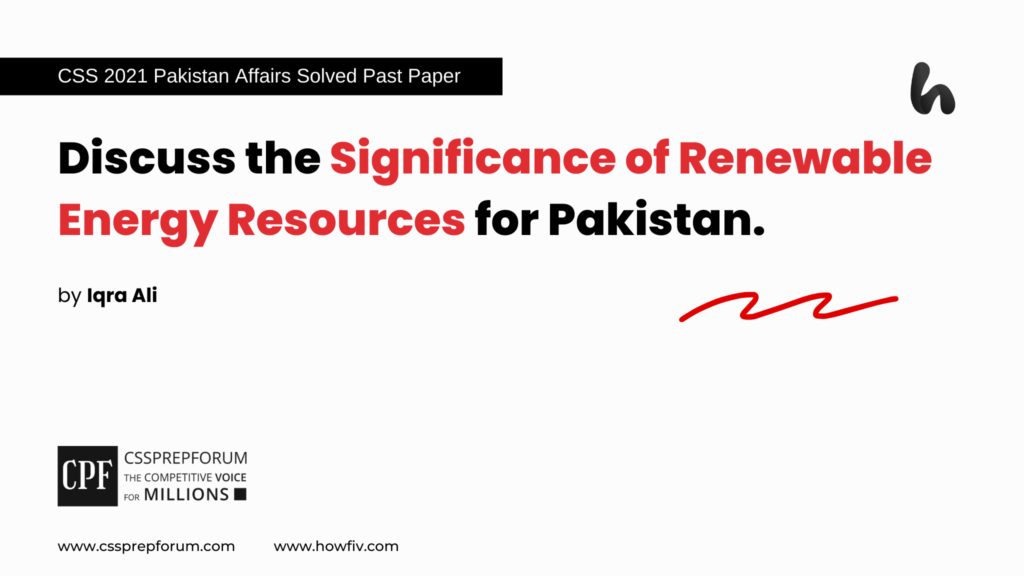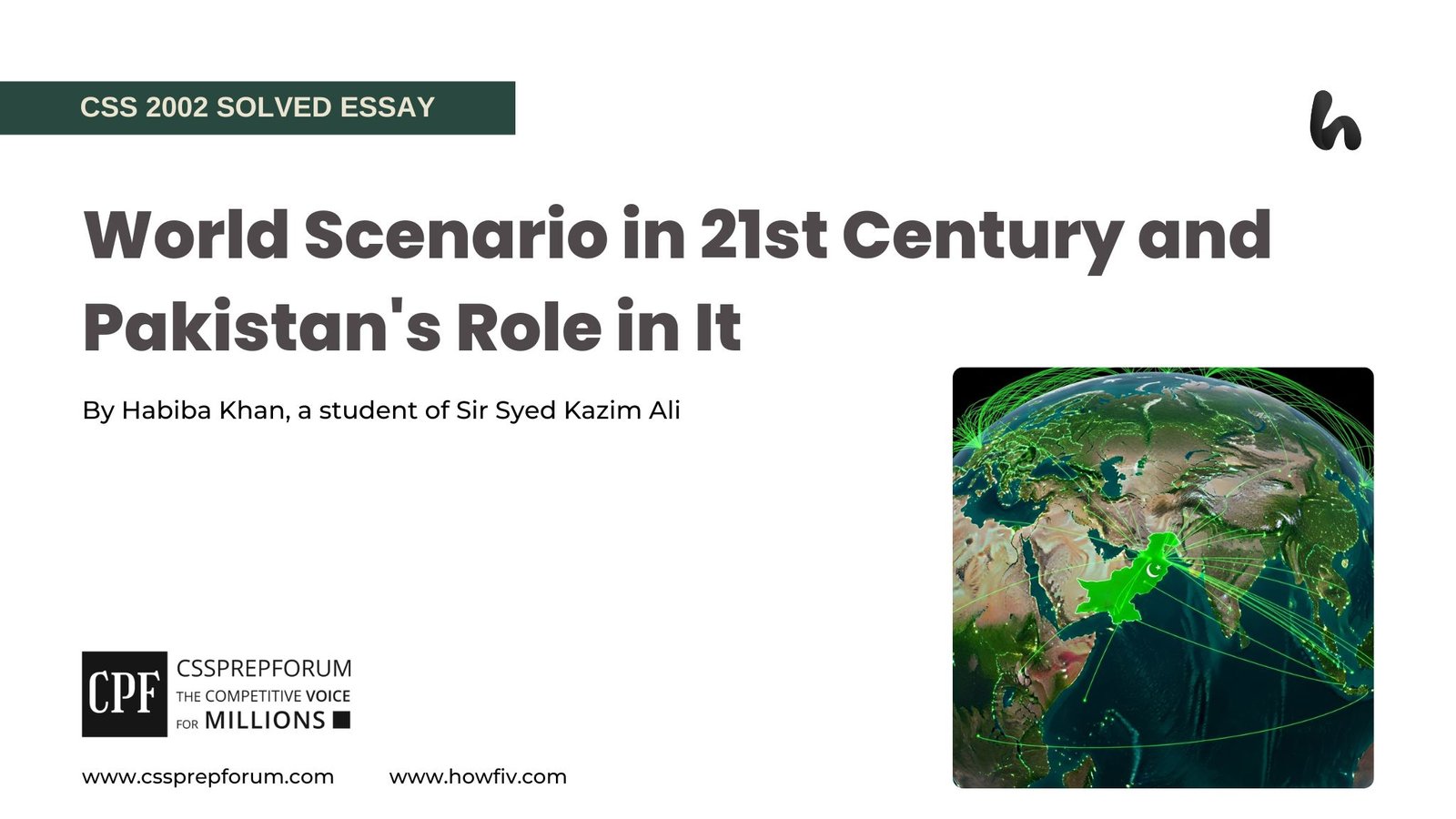CSS Solved Pakistan Affairs Past Paper 2021 | Discuss the significance of renewable energy resources for Pakistan.
The following question of CSS Pakistan Affairs 2021 is solved by Miss Iqra Ali, the best Pakistan Affairs Coach, on the guided pattern of Sir Syed Kazim Ali, which he taught to his students, scoring the highest marks in compulsory subjects for years. This solved past paper question is uploaded to help aspirants understand how to crack a topic or question, how to write relevantly, what coherence is, and how to include and connect ideas, opinions, and suggestions to score the maximum.

Question Breakdown
This question needs a discussion on the significance of renewable energy sources for Pakistan as it experiences a continuous crisis of electricity and faces a growing need for clean energy. The question also asks for an examination of the country’s renewable energy potential, feasibility in Pakistan’s climate, and the almost equally beneficial impacts it has on the country’s economy, environment, energy security, and social development. Moreover, it requires answering the question regarding how the power of renewable energy can enhance Pakistan’s global image and long-term sustainability.
Outline
1-Introduction
2-The Worsening Energy Crises in Pakistan: Impacts and Urgency of Their Solutions
3-The Renewable Energy Sources suitable for Pakistan
4- The Multi-pronged Significance of Energy Resources for the Sustainability of Pakistan
- ✓Ensuring Energy Independence and Economic Stability through reduction in Imported fuels, Electricity cost and Encourage cost-effective electricity and Foreign Direct Investments in Green Energy.
- ✓ Enhancing Rural Uplift and Social Uplift with expansion of Renewable Energy Access for improved Health, Educational opportunities and Reliable Electricity.
- ✓Strengthening Energy and Political security which will ensure National Energy Resilience against Global Fluctuations.
- ✓Reducing Green greenhouse gas emissions by efficiently tackling Environmental challenges, adopting Clean Energy solutions, and preserving Natural Resources for the long-term sustainability of the country.
- ✓Boosting International Cooperation and tech advancements by collaborating with Leading Nations.
- ✓Enhancing Domestic Policy Implementation and strategic framework by Strengthening the role of AEDB (Alternative Energy Development Board).
5-Critical Analysis
6-Conclusion
Introduction
Pakistan is facing a severe energy crisis, with frequent power shortages and increasing expenditure on energy, which are severely straining the country’s economy. With the increase in demand for electricity, there is a higher need for sustainable and affordable energy solutions. Thus, renewable energy resources like solar, wind, hydropower and biomass provide a viable option of substitute for fossil fuels, thus making us less dependent on imports and ensuring long term energy security. With Pakistan‘s geographical and climatic advantages, the country has the potential to capacity develop renewable energy. However, the solar potential is very vast in Balochistan, strong wind corridors in Sindh and mass hydropower capacity in the Northern region facilitate a successful transition towards a sustainable energy. Renewable Energy investment would help to significantly boost Pakistan’s economy by drawing foreign investment, reducing its fiscal burden on energy import, and industrial growth from a stable and low-cost source of power. It is environmentally friendly as it lessens carbon emissions and contributes to combating climate change as it adopts global level sustainability commitments. Additionally, renewable energy is part and parcel of Pakistan’s development vision, with the social benefits of production increase and rural electrification added to the improved living standards. Therefore, the promotion of clean energy solutions is no longer an option but a necessity for Pakistan’s long-term economic resilience and environmental sustainability.
The Worsening Energy Crises in Pakistan: Impacts and Urgency of Their Solutions
The problem of the energy crisis in Pakistan has only intensified over the years because of the increasing demand, outdated infrastructure, mismanagement and dependence on imported fossil fuels. The country has an electricity shortfall of more than 5,000 to 7,000 MW and often faces frequent blackouts and load shedding. This disrupts industries, businesses and daily life. Financial instability exists due to the circular debt of the power sector that has surpassed PKR 2.5 trillion (World Bank, 2023). Consequently, the impact it incurs is devastating on industries, causing productivity losses totalling 2-3 per cent of GDP on an annual basis (Asian Development Bank, 2022) and on businesses with high operational costs. In fact, 40 percent of the population has no access to electricity, and households have long power cuts, especially in rural areas (IEA, 2023). Power shortage also affects education and healthcare since it grinds the internet in digital learning and the facilities in medical. Additionally, Pakistan is one of the top 10 most climate-vulnerable countries, as it further degrades environmental issues with the burning of fossil fuels (Global Climate Risk Index, 2023). Urgent solutions are required. They report and advocate for renewable energy expansion, better grid management and energy efficiency reforms. Now that China and Germany have successfully transitioned to clean energy, there is no reason to believe that sustainable alternatives cannot be viable and beneficial. Pakistan’s energy crisis will continue to restrain economic growth, social stability and environmental sustainability if no immediate action is taken.
The Renewable Energy Sources suitable for Pakistan
| Renewable Energy Resource | Geographic and Climatic suitability & abundance in Pakistan | Potential Utilization |
| Solar Energy | Hydropower potential in numerous rivers and mountainous regions. | High solar radiation in three major provinces except KPK. |
| HydroPower | Integration into the national grid, Hybrid solar wind energy systems and Wind power plants. | Dams and Micro-hydro setups in remote areas for large and small scale hydropower projects. |
| Wind Energy | Wind corridors in dry regions like Sindh and Baluchistan. | Research-based pilot projects in coastal areas of Gwadar and Karachi. |
| Tidal and Geothermal Energy | Coastal Belts and Thermal springs suitable for experiments | Research based pilot projects in coastal areas of Gawader and Karachi. |
| Biomass and Waste Energy | Availability of urban waste, livestock waste and agricultural residues. | Sustainable agricultural waste managementt, waste to energy projects for urban centres and Biogas plants. |
The Multi-pronged Significance of Energy Resources for Sustainability of Pakistan.
- ✓Ensuring Energy Independence and Economic Stability through reduction in Imported fuels, Electricity cost and Encourage cost-effective electricity and Foreign Direct Investments in Green Energy.
The high percentage of imported fossil fuels to which Pakistan is reliant has caused an uncontrollable economic burden that has only worsened its balance of payments crisis and continues to burden the country with higher electricity costs. The shift to renewable energy is an efficient as it constitutes a reduction in high import costs as well as a measure for economic stability over the long run. At a time when Pakistan spends over $13 billion annually on fuel imports, foreign exchange reserves account for about $13 billion (Pakistan Economic Survey 2022-23). The country can save money at the same time as it secures independence from energy production, by investing in renewable energy sources such as wind, solar and hydropower. Regardless of where you are around the globe, options to create energy using renewables are obvious. Solar power, for example, has seen its costs come down almost by 89 per cent since 2010 (International Renewable Energy Agency, 2023), so it is now amongst the cheapest forms of electricity available. Provided with Government permissions, Pakistan’s Gharo-Jhimpir wind corridor alone would generate up to 50,000 MW and therefore greatly reduce Pakistan’s costly LNG import requirement. To a similar extent, the Chinese Belt and Road Initiative (BRI) has already invested over US $5 billion into Pakistan’s renewable sector including Foreign Direct Investment (FDI) in green projects and infrastructure. Ban Ki-moon, former UN Secretary-General: “The stone age did not end because of the lack of stones and the oil age will not end due to lack of oil, but due to finding better alternatives”. Additionally, Pakistan must take note of the fact that renewables should not be embraced simply as an alternative energy source to save the country from the spectre of imminent energy crisis, but instead as a financial necessity to keep the country ‘afloat’ (or afloat in other terms) and for future growth of industry in the country.
- ✓ Enhancing Rural Uplift and Social Uplift with expansion of Renewable Energy Access for improved Health, Educational opportunities and Reliable Electricity.
Sustainable energy access has the potential to transform rural communities in Pakistan as it makes reliable electricity available, improves health and potential educational opportunities. As of today, approximately 40 per cent of Pakistan’s rural population does not have access to electricity (World Bank 2023), which makes the environment very poor, creating stagnation in the economic sphere and limiting educational and healthcare services. In order to bridge this gap in the sustainable development of rural areas, renewable energy solutions such as off-grid solar systems, micro hydropower plants, and wind farms can help. One of most important impacts of renewable energy expansion are health benefits. Transitioning to solar and biogas energy can alleviate most health risks especially in women and children experienced by rural households. For instance, the Roshan Gharana project in Sindh has installed solar panels in off the grid villages to enhance drastically the access to healthcare. However, learning conditions have become difficult due to the fact that over 10,000 schools in Pakistan still lack electricity (Pakistan Bureau of Statistics, 2023). However, the latter programs, the Agha Khan Foundation and the Punjab Solar Initiative, have even enhanced literacy by providing students with digital learning tools, lighting and cooling systems made possible by solar power. In countries like Bangladesh, the Solar Home System (SHS) program has electrified more than 20 million people, both for improved education, healthcare and rural business alike. Such models can be replicated by Pakistan to enable the marginalised communities to decrease urban migration and strengthen self-sustaining rural economies.
- ✓Strengthening Energy and Political security which will ensure National Energy Resilience against Global Fluctuations.
Nearly 70 per cent of Pakistan’s energy needs are imported at the cost of approximately $20 billion per year (State Bank of Pakistan, 2023). The country’s extreme dependence on this is extremely vulnerable to geopolitical tensions, fuel price volatility and supply chain disruptions. By investing in renewable energy such as solar, wind and hydropower, Pakistan will reduce dependency on imported fossil fuels, stabilizing Pakistan’s economy and protecting it from the global energy crises, including the Russia-Ukraine war, which resulted in very high oil and gas prices. With renewables integration, Pakistan can follow their example by incorporating more wind and solar farms in Sindh and Balochistan, plus hydropower expansion in Khyber Pakhtunkhwa and Gilgit-Baltistan. It already sells 1000 MW from its Quaid-e-Azam Solar Park, also present in Punjab, a feat which shows that large-scale renewable projects are indeed the game changer. However, from a political standpoint, energy self-sufficiency enhances a nation’s sovereignty. Policy making autonomy is also constrained by the dependence on energy imports which necessitates Pakistan to abide by any conditions put forward for fuel supplies by international parties. Transitioning to renewable energy not only helps overcome the precarious position of Pakistan’s economy and politics but also enhances energy security without affecting either the sovereignty or the economic growth of the country.
- Reducing Green House Gas emissions by efficiently tackling Environmental challenges, adopting Clean Energy solutions, preserving Natural Resources for long term sustainability of the country.
Pakistan is among the top 10 most vulnerable countries to climate change (Global Climate Risk Index 2023) and faces very severe environmental challenges. Its long term stability is threatened by rising temperatures and impatient monsoons, glacial melt in the Hindu Kush Himalaya region. A major cause is the severe reliance of Pakistan on fossil fuels, which indeed emit greenhouse gas (GHG) emissions, air pollution and environmental degradation. The switch to renewable energy can significantly reduce emissions, conserve nature, and safeguard environmental sustainability. However, Pakistan possesses a significantly huge solar energy potential of 2.9 MW and a wind energy potential of 43,000 MW (Alternative Energy Development Board, 2023). The Gharo-Keti Bandar Wind Corridor in Sindh, can help us in minimizing the use of fossil fuels and provide clean energy on a large scale. Further to these, the hydropower projects, such as the Diamer-Bhasha Dam and Mohmand Dam, would curb emissions and also ensure the conservation of water. Therefore, environmental sustainability is directly linked to economic stability. The loss of $3.8 billion a year to climate disasters is costing Pakistan (World Bank, 2023). Mobilizing funds to reduce these losses will not only be wise but also will establish a sustainable, climate resilient economy based on clean energy investments. Pakistan can save its natural resources, improve public health and protect the future generation from environmental catastrophe by adopting green energy solutions.
- ✓Boosting International Co-operation and Tech-Advancements by collaborating with Leading Nations
Collaboration with leading nations in clean energy will enable Pakistan to avail state-of-the-art technologies and attract foreign investment and modernization of its energy sector. Investments in Pakistan’s renewable energy are happening in countries such as China, Germany and UAE. In its own name, under the plutocratic China-China-Pakistan Economic Corridor (CPEC) Green Energy Initiative, China has promised to assemble solar and wind farms, such as the 300 MW Gwadar solar project. Similarly, Germany’s KfW Development Bank has financed hydropower projects such as Harpo Hydropower Station in Gilgit-Baltistan. Not only do these collaborations bring funding, but they also bring expertise in the area of energy-efficient technologies. Pioneering smart grids, battery storage and efficient wind turbine technology under Danish and Swedish leading nations. Since Pakistan can adopt and localize these advancements to improve its energy efficiency and grid resilience, it is a matter of interest to Pakistan. The role of Pakistan in these global platforms like COP28, the International Renewable Energy Agency (IRENA) and the Paris Agreement plays an important role in its diplomatic footprint. As countries start to invest aggressively in renewables, international organizations such as the World Bank and the Green Climate Fund support them. Using international partnerships, Pakistan can advance its technology, lessen dependence on fossil fuel imports, and gain regional leadership in sustainable energy.
- ✓Enhancing Domestic Policy Implementation and strategic framework by Strengthening the role of AEDB (Alternative Energy Development Board).
Renewable energy will help Pakistan to strengthen its domestic policy implementation and enhance the country’s long term energy strategic policy. Also, this will pave the way to the working of such bodies at the helm of the renewable energy journey of Pakistan, the Alternative Energy Development Board (AEDB) being one of them. AEDB can expand its capacity to guide policies, attract international partnerships and provide a policy framework for renewable energy integration by increasing its investments in solar, wind, hydro and biomass projects. With the increasing number of renewable energy projects, AEDB’s role in the policy enforcement, approval and monitoring will become even more important for indicating to Pakistan’s National Energy Policy (NEP). As more renewables are integrated, the AEDB is key to coordinating across other relevant ministries such as the Ministry of Water and Power, Ministry of Finance, Ministry of Environment, and other relevant ministries to enhance policy coherence across ministries. Including renewable energy solutions can also be advantageous to various frameworks, I.e. Pakistan Vision 2025, as well as CPEC candidates. The frameworks of such importance are on sustainable development, economic stability and energy security. AEDB too will also play a major part in achieving the Paris Agreement’s energy goals by effectively leveraging renewable energy.
Critical Analysis
Renewable energy resources have significant importance for Pakistan given the severity of this country’s energy crisis, its environment as well as its need for sustainable economic growth. On the other hand, Pakistan sees renewable energy sources, including solar, wind and hydropower, as offering a viable prospect to attain energy security, including averting dependency on imported fuels and cancelling the consequences of climate change. It is also necessary for Pakistan to bridge technical and financial hurdles to use these renewable sources efficiently in the existing grid. Furthermore, governmental and institutional reforms are also needed to encourage private sector involvement and attract international investment. Renewable energy, however, has the potential to enhance economic resilience through job creation, lowered energy costs, and better environmental management. Planned and if well implemented, it can change the energy face of Pakistan and help it to develop in a sustainable way.
Conclusion
Renewable energy resources have a high significance for Pakistan; they provide multifold solutions to the country’s energy crisis, economic instability, environmental degradation, and geo-political vulnerabilities. The abundant and well-suited to the geographical and climatic conditions of Pakistan, renewable energy sources such as solar, wind and hydropower, if integrated into the energy mix, will make Pakistan’s considerations worldwide more attractive in an international quid share for the cooperation and technology transfer with more developed nations. Despite that, the realization of renewable energy would depend largely on the capability to solve some key barriers like infrastructure issues, policy inconsistency and financial investment. Thus, both a strategic framework and international stakeholders’ involvement is critical for Pakistan to achieve the renewable energy agenda.
CSS Solved Past Papers’ Essays
Looking for the last ten years of CSS and PMS Solved Essays and want to know how Sir Kazim’s students write and score the highest marks in the essays’ papers? Then, click on the CSS Solved Essays to start reading them.
CSS Solved Essays












